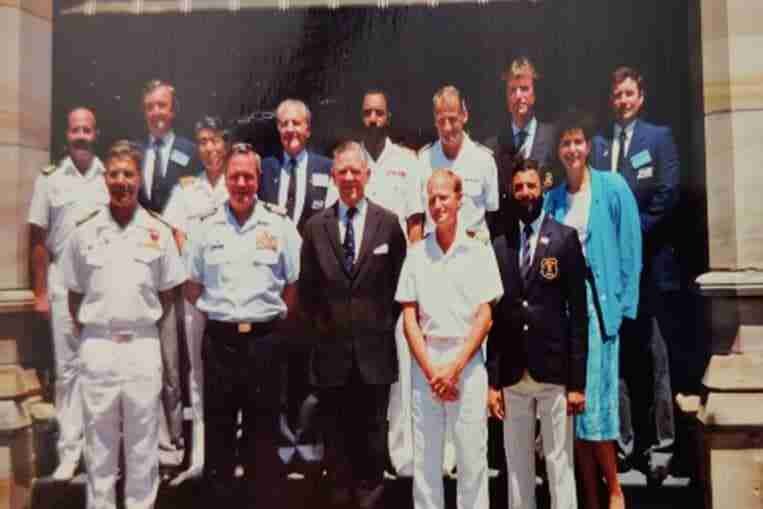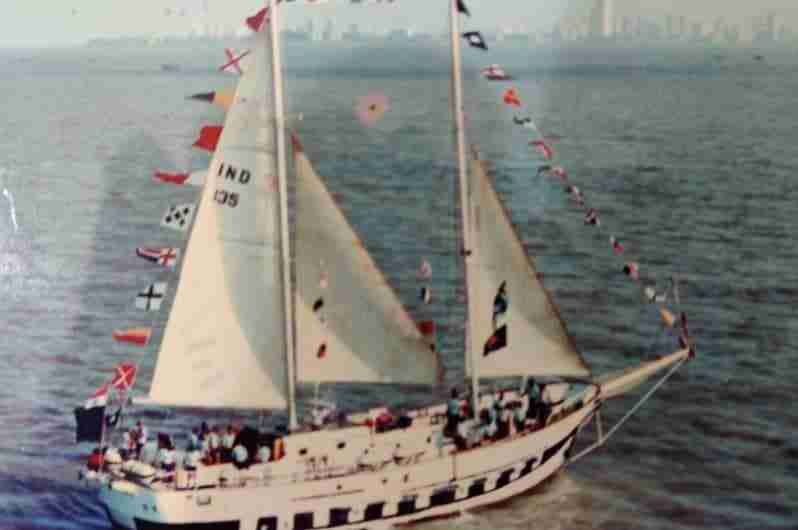What makes people climb mountains, traverse on foot to the ends of the earth or set sail across the high seas? Simply because it’s there. Whatever be the reason, mere words can never totally capture the essence of such human endurance; one has to taste it for oneself.
Sailing as a sport can be extremely tough if one is in competition, but as a leisure sport, it can be very relaxing as well as invigorating. It can help appreciate the elements in its correct perspective, with admiration, caution and respect. The thrill of it all can almost make one’s tension ride away gently with the waves.
The tall ship event
On 14 Sep 1987, STS Varuna with a crew of 30, set sail to partake in the Australian bi-centennial celebration on 26 January 1988 at Sydney. I was a Lt Commander then and for me to command a crew of 30 on such a voyage was not only a mere adventure but a mission. We returned on 15 April 1988 after undertaking a voyage for seven months and covering a distance of 28,100 km. On our return, we were seven months older, years wiser and brought with us memories to last a lifetime.

On invitation from the Australian Government, India was requested to participate in the Tall Ship event of the Australian Bicentennial celebration. What was this event all about?
On 13 May 1787, a fleet of 11 Tall Ships under the command of Capt Arthur Phillip carrying the first convict settlers, sailed from England and reached Botany Bay on 18 January 1788. Eight days later they moved to settle at port Jackson. This small convict settlement grew to become what is Sydney, Australia’s biggest city. As part of the bicentennial celebrations, the basic idea of the Tall Ships event was to get such ships from the world over, enacting in a way the epic first voyage that is known today as the first fleet.
A total of 169 ships from 20 countries thus participated in the parade of sails on 26 January- Australia’s national day. Prince Charles and late Lady Diana were the chief guests. Varuna (meaning the Lord of the Sea) being the type of ship used by the first settlers was chosen to take a proud place in the parade of sails. It took Varuna seven months sailing on different routes to complete the expedition.

That we accomplished this difficult sojourn without any injury or loss of life despite considerable hardship, is commendable and goes to the credit of the very fine crew I had. What we learnt on the voyage couldn’t have been done in normal life. It not only matured all of us to tackle different situations but gave us the courage to overcome problems. In addition to the break downs the vessel had, we had to cope with the problems like scarcity of water which was carried in small quantities.
Sailing along
With a cook on board and rations dispatched to all ports of call in advance, food was not a problem. The weather was for the most part of the voyage hot and unbearable at times, leading to sunburns. The biggest blow, however, came while negotiating the Great Australian Bight, when Varuna was struck by a severe storm and lost both her masts along with sails.
This forced us to continue to Sydney with a fore and aft rig instead of the original square rig. The accident thus converted the Tall Ship into a functional fore and aft Schooner, a configuration in which she took part in “The parade of sails” at Sydney on the historic occasion and also made her way back to Mumbai.
The biggest blow, however, came while negotiating the Great Australian Bight, when Varuna was struck by a severe storm and lost both her masts along with sails.
For me, the expedition was the most challenging of my career. I had the added responsibility of carrying a bunch of raw cadets with no sailing background, who had to be trained. At times when the winds got rough and the cadets had to handle the sails from the top of the mast, it made things all the more, risky. But it was a great adventure. Many people later asked me if I dreaded not completing the expedition at any stage. Looking back, I think we were all confident right from the start, that we would make it. I personally had no doubts, not even when we lost our mast.

A typical day on the voyage began at six in the morning and the time between breakfast and lunch was spent in cleaning and maintenance of the ship. Afternoons were devoted to classes and evenings for writing journals and preparing for exams. This apart, the crew had to do their watchkeeping duties. This should not imply that it was all work and no play. Indoor games and other competitions such as tug of war were conducted to break the monotony.
Varuna was accorded a warm welcome by one and all. It was the smallest square ship that paraded in Australia and for me, it was an eye-opener to see such a big fleet of Tall Ships that had come from across the world. From Freemantle to Sydney, every port we called on, there was some function or the other for the crew. There were also sightseeing tours organised for us and a lot of felicitation parties, not only in Australia but in countries like Malaysia, Indonesia and Singapore that we touched.
All in all, it was a grand adventure and a great experience, not only for me but for each of the crew members. Certainly, undertaking an expedition of this magnitude and accomplishing it so successfully despite the odds, speaks volumes of the character, courage and determination of my crew.
As Bob Hawke, the then Prime Minister of Australia said in his speech, “I am especially proud of the Indian Tall Ship Varuna and appreciate the courage of the crew in getting Varuna to Sydney. We have a lot to learn from them”. My crew deserves great accolades. Carry on mates.


